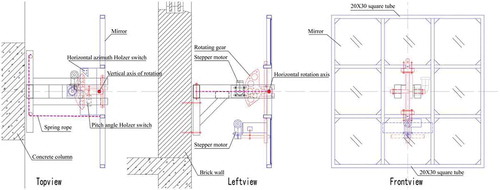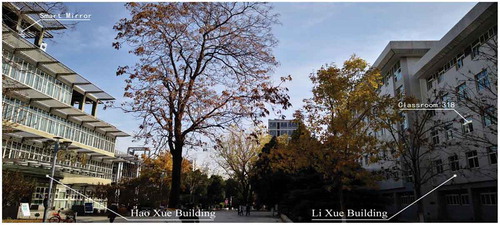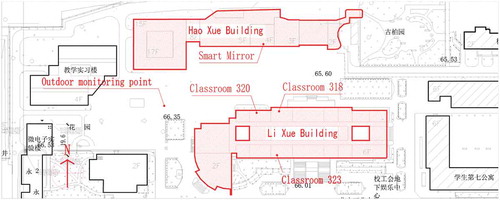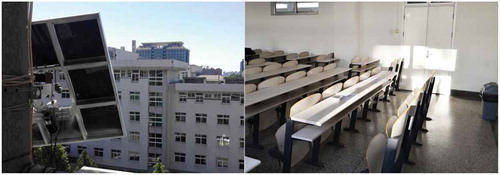 ?Mathematical formulae have been encoded as MathML and are displayed in this HTML version using MathJax in order to improve their display. Uncheck the box to turn MathJax off. This feature requires Javascript. Click on a formula to zoom.
?Mathematical formulae have been encoded as MathML and are displayed in this HTML version using MathJax in order to improve their display. Uncheck the box to turn MathJax off. This feature requires Javascript. Click on a formula to zoom.ABSTRACT
The mode of solar energy utilization includes PV, solar heating,hot water and so on, but it is difficult to improve the utilization rate nowadays. Using computer technology, a Smart Mirror was developed and installed on the roof of a building in Beijing, and related experiments have been carried out during 2017–2018. The results show that the device can reflect 48.6% of the solar radiation and 17.4% of ultraviolet into the building in winter. The utilization rate can reach over 194% of the traditional modes. Its efficiency is equivalent to 41.4% of the southward window of the building. Natural lighting is also improved significantly. Based on the “central diversion,” “wind moment counteract” and “prestressing,” its stability, structural strength and accuracy meet the application needs.
Graphical Abstract
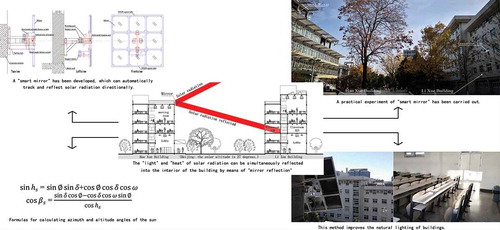
The ways of solar energy utilization in architecture field include hot water (Yan, Zhien, and Tension Citation2012; Cheng Citation2017; Gu Citation2014), PV(Kangqi Citation2016; Liu and Shaoyue Citation2014), solar heating and so on, and so far the actual utilization rate is up to about 25%(Li Citation2016; Buyaming Citation2006). Computer technology promotes the utilization. For example, Wang, Huanguang, and Liang (Citation2010) used computer technology to control solar hot water, kept the water temperature of pipeline relatively constant, and improved the utilization rate. Guo (Citation2011) adjusted the angle of “smart metal sunshade” according to the change of solar trajectory in different periods of a day to improve the shading effect of the building interior space. Wu and Yanqiang (Citation2016) proposed to use computer technology to automatically track solar radiation in order to save energy and increase nature lighting. Experiments that have been carried out in 2017 verify the feasibility (Wu and Yanqiang Citation2017). At April 2018, the “Smart Mirror” was successfully developed and installed in Hao Xue Building. By November 2018, a total of 8 months of test, operation and related monitoring were carried out.
1. Experiment on using “Smart Mirror” to increase solar radiation and save energy
The basic principle of “Smart Mirror” is to reflect the solar radiation into building automatically and directly so that it can get abundant solar radiation, thereby improve natural lighting and reduce heating energy consumption during winter (). The key technologies include: (1) According to the solar trajectory, the relative relationship between the sun, the mirror and the north window of Li Xue Building can be calculated automatically by single-chip (Li et al. Citation2014) (), so as accurately calculate the horizontal azimuth and pitch angle required for the normal of the mirror. (2) The “stepping motor + reducer” adjust the elevation angle and horizontal azimuth angle of the mirror accurately (Xufen and Kaidi Citation2012). (3) The mirror reflects the solar radiation (light + heat) into Li Xue Building automatically.
Figure 1. The experimental sketch of increasing solar radiation and natural lighting using “Smart Mirror.”
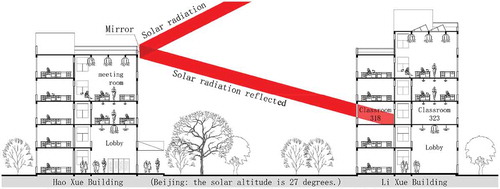
The basic features of “Smart Mirror” include: (1) Structure stability design based on “mirror wind moment counteract each other,” “central orifice diversion” and “prestressing..” (2) Mirror rotation structure based on “step motor + reducer” with “pitch angle and horizontal azimuth angle respectively controlled.” (3) Error zeroing device based on the Holzer proximity switch ().
2. Use “Smart Mirror” to get more natural lighting and save energy
Summary of the experiment: On 18 April 2018, the “Smart Mirror” was installed on the east fifth floor of the Hao Xue Building (left of ). It started to operate on April 21, automatically track the solar radiation and reflect it into the classroom 318 of the Li Xue Building (right of ). The experiment have been run about 8 months until 13 November 2018
Objects: Hao Xue Building is located in the north of Li Xue Building. The distance between the two buildings is about 40.5m (). The “Smart Mirror” is installed on the south-facade of the concrete column on the five-story roof. Both of Hao Xue Building and Li Xue Building are teaching buildings. The mechanical and electrical equipment of each classroom is similar and the story height is the same.
Experiments situation: The accuracy, stability, illumination and ultraviolet intensity of “Smart Mirror” were monitored and compared each other by typical weather such as sunny, cloudy, windy and haze in heating season and transitional season. Taking the distance of the “spot” from the center of the target window as an index, taking photographs to record the deviation, estimating the deviation distance using the wall tile as a reference, and measuring its accuracy and stability. Place the illuminometer on the desktop of each classroom and measure its illumination. Pplaced it flat on the outdoor, one meter above the ground.,and the head shadow was used to cover the probe of the illuminometer. The outdoor diffuse light intensity in four directions was measured and the average value was obtained. The illuminometer is perpendicular to sunlight and the intensity of direct radiation is measured. Ultraviolet ray tester is perpendicular to sunlight to measure the ultraviolet intensity of direct radiation. The student’s subjectively evaluation for different sunlight reflections were taken as a criterion for judging glare intensity ().
Experimental equipment: A set of “Smart Mirror” developed by our team, and KONICA brand ILLUMINANCE METER T-10 Illuminometer 4, accuracy 1lx. Pentax R-400 station 1, ranging accuracy 0.1mm, angle precision 2.” TENMARS UVAB Ultraviolet Tester manufactured by Taiwan Shijun Electronics has a resolution of 0.001 MW/cm2, induction wavelength of 290–390 Nm and accuracy of 3%. Using Beijing local meteorological data.
2.1 Accuracy of “Smart Mirror”
The experiment shows that the key factors that influence the accuracy of “Smart Mirror” include: (1) Accuracy of the measurement of the “North,” “horizontal azimuth” and “pitch angle” of the mirror’s normal. The “Gyroscope Total Station” with its own north-pointing function seeks the north, and its “north” direction is geographically north, that is, at right noon on the day. In these experiments, when measured northward, the relative time at that time was 12:15:43 Beijing time instead of 12:00 noon. The measured horizontal azimuth should be counter-clockwise (of 181.18°) and pitch angle of 15.36°. (2) The daily error of the mirror should be corrected every day. The experiment is based on “Holzer proximity switch” as the stopper, the device is fixed and reliable, the first driving device to the initial position to stop, and then drive the mirror focus on the target window, note the horizontal and vertical rotating steps, the back of the initial position of the actual horizontal angle, pitch angle. (3) The structural accuracy of “Smart Mirror.” The mirror rotates around the “cross axis.” The error of the rotation center between the mirror and the device is about 20 mm. There is no obvious deviation error in the actual operation. (4) Precise level and pitch rotation mechanism. The horizontal azimuth and elevation angle of the mirror is independently controlled by “stepping motor + reducer.” The theoretical accuracy is 0.002° and the driving force is 7.5 kgf, which meets the relevant requirements.
2.2 The stability of “Smart Mirror”
“Smart Mirror” adopts the following four technical measures to increase its stability: (1) Mirror frame stability design based on “mirror wind moment counteract each other.” Due to the use of the mirror that is completely symmetrical based on the center of rotation, most of the wind moment counteracted each other. (2) The airflow guiding structure of the “frame opening.” The size of the mirror frame is 90cm*90cm, and the central hole is 30cm*30cm, which can guide the airflow to speed up the circulation and effectively enhance the stability of the mirror. (3) The rocking restraint mechanism of “prestressing.” By prestressing the mirror frame in a certain direction in both horizontal and vertical directions, the shaking of the mirror surface under strong wind can be further reduced effectively. (4) The “cross shaft” stable rotation mechanism. The structure is further simplified and the strength of the structure is further increased when the rotating axes in the horizontal and vertical directions are adjacent to each other (). In the experiment on 28 May 2018, without adding prestressing, when the wind force is greater than 4 levels, the mirror frame would shake slightly. When the wind force is greater than 5 levels, the spot shaking is obvious. At this time, the spring rope and the mirror frame are fixed. After adding prestressing, the shaking basically disappears ().
2.3 Solar utilization rate of “Smart Mirror”
The adding of solar radiation can meet some of the users’ physiological and psychological needs. Theoretically, the utilization rate of solar radiation by “Smart Mirror” is: solar radiation incidence angle reduction coefficient * mirror reflectance * incident window first layer glass transmittance * second layer glass transmittance, namely: in winter (the solar altitude angle is 24°, take Beijing as an example): 91%*85%*85%*85% = 55.9%, in summer (solar altitude angle 45°), the utilization rate should be: 70.7%*85%*85%*85% = 43.4%. Generally speaking, the visible light accounts for about 50% of the total solar radiation energy, the infrared light accounts for about 43%, and the ultraviolet rays accounts for about 7%. Mirror can effectively reflect visible light, infrared light, and ultraviolet rays, but the visible light accounts for the largest energy proportion, and is not easily absorbed by glass, so these experiments adopt illumination value as an index to infer the utilization rate of solar radiation reflected by “Smart Mirror.”
Solar radiation utilization rate based on illumination comparison: These experiments show that the working efficiency of the mirror is sensitive to atmospheric quality. When the weather is the best or good, the outdoor illumination were 105600lx and 79700lx in May 25 and 30, 2018, and the range of variation were small. When the air quality was excellent in 8 October 2018, the illumination was 60300lx outside, and reduced to 29330lx, or about 48.6%, when it was reflected into the classroom 318, slightly below the theoretical value (). But in early summer, even when the air quality was good in 13 May 2018, the illumination is 84800lx outside, after it was reflected into the indoor, it turned to be only 2860lx, about 3.3% of the outdoors’. The difference between them was about 15 times. The reason may be that the solar altitude angle was larger and the atmospheric transparency was lower in summer.
The experiments also show that the total amount of radiation provided by the “smart mirror” is 10–16 times as much as that of the normal classroom in the north and 1–8 times as much as that of the classroom in the south of Li Xue Building. The total radiation intensity is equivalent to 48.6% of the classroom in the south of Li Xue Building. When the air quality is good, the indoor radiation of the “Smart Mirror” is about 10–16 times that of the north-facing classroom without direct solar radiation. The utilization rate of solar radiation is about four times higher than that of south-facing classroom, because it can provide stable solar radiation for up to 6–8 hours per day (). These experiments show that with the help of smart mirror, the daylight factor of the classroom varies greatly. In severe polluted weather in winter, the daylight factor is only 4%, while in summer, the daylight factor can reach 37% ().
Table 1. The formula for calculating solar elevation angle and azimuth angle.
Table 2. operation experiment of “Smart Mirror” under windy weather conditions.
Table 3. Indoor and outdoor illumination comparison assisted by “Smart Mirror” (providing solar radiation for classroom 318 with a “Smart Mirror”) (Unit: lx).
Table 4. Comparison of UV intensity between rooms (unit: MW/cm2).
Ultraviolet reflected by the mirror: Solar radiation is short-wave radiation, most of the whole wavelength can be reflected. The bactericidal effect of the radiation is mainly ultraviolet, whether it meets the health requirements, can be compared with ultraviolet intensity as an indicator (Jawaad Ahmed Ansari, Ismail, and Farid Citation2019). Ultraviolet intensity was used as an index to determine the effect of “Smart Mirror” on improving indoor hygiene condition. Experiments show that the “Smart Mirror” can reflects about 17.4% of the ultraviolet radiation into room in winter, which is about 65% of the South classroom or five times of the North classroom ().
The transmittance of double glasses of window: Data monitoring on 1 July 2018 shows that the illumination of solar radiation passing through ordinary double glasses in actual operation decreases from 105000lx to 44100lx, with a decrease of 42%, slightly less than 51.5% of the theoretical calculation. The irradiance of the solar radiation reflected by the silver-plated glass mirror and then into the building room decreases from 105000lx to 24150lx, with a decrease of 23%, which is about 55% of the direct incidence of solar radiation
2.4 Avoiding glare
Avoiding glare is very important for the classroom. The experiments show that the direction of light incidence has an important influence on the dazzling. If the reflected light is incident from the back of the students, the desktop is not directly illuminated by the sun due to the body’s occlusion, which can avoid glare, and the students can learn comfortably. However, if the reflected light is incident from the front, the reflected light will be directly illuminated on the desktop, which will produce dazzling light, affecting normal learning activities ().
3. Conclusion
“Smart Mirror” utilizes the “light + heat” at the same time, which improves the utilization rate of solar radiation from 25% to 48.6% significantly. The “wind moment counteract each other” and “central orifice diversion” improve the operation stability, simplify the structure and reduce the weight. The combination of “cross shaft” and “prestressing” can solve the problem of mirror shaking and improve the durability of the device. The mirror control mode of “stepping motor + reducer” significantly improves the accuracy of directional reflection, reduces the cost, greatly reduces the size of the structure, and presents in an aesthetic way. This experiment demonstrates that “computer technology + solar energy utilization” has great potential in building energy conservation and natural lighting. Its solar radiation utilization rate is much higher than traditional solar hot water, PV or heating, which can provide good light and thermal comfort for users. However, the ash deposition on the mirror have a certain effect on the incident and reflected solar radiation. If the incident angle is not good, glare may also occur. Experiments show that the use of “Smart Mirror” can provide stable and long-term solar radiation for buildings, and its total radiation is much higher than that of general south-facing windows. Its light and thermal comfort are high and ultraviolet light is abundant.
Pictures source: all the pictures in this article are provided by the authors.
Disclosure statement
No potential conflict of interest was reported by the authors.
Additional information
Funding
References
- Ansari, J. A., M. Ismail, and M. Farid. 2019. “Investigate the Efficacy of UV Pretreatment on Thermal Inactivation of Bacillus Subtilis Spores in Different Types of milk[J].” Innovative Food Science and Emerging Technologies 52: 387–393. doi:10.1016/j.ifset.2019.02.002.
- Buyaming. 2006. “Research on application technology of solar heating system in residential buildings in small towns.” PHD diss. Tongji University
- Cheng, M. 2017. “Application of solar water heating system in residential buildings.” PHD diss. Hebei University of Science and Technology.
- Gu, L. 2014. “Solar energy. Economic effect evaluation and policy suggestions on the application of hot water system in residential buildings.” PHD diss. Xi’an University of Architectural Science and Technology.
- Guo, J. 2011. “Guangzhou Development Center Building Intelligent Sunshade System Design.” Central China Building 29 (01): 49–51.
- Kangqi. 2016. “Research on the integration of solar PV design of residential buildings in hot summer and cold winter areas.” PHD diss. Hubei University of Technology.
- Li, H. 2016. “Research Progress of Solar Energy Utilization.” Scientific and Technological Innovation and Application, no. 09 (157): 38–39.
- Li, Z., L. Zhigang, Y. Cungui, and C. Na. 2014. “The Design of the Solar Tracking System Based on Single-Chip Computer.” Electronic Design Engineering 02: 188–190.
- Liu, X., and S. Shaoyue. 2014. “PV Technology of Solar Energy and Its Application in Rural Areas. Application of Residential Buildings.” Journal of Qingdao Niversity of Technology 35 (05): 37–41.
- Wang, M., H. Huanguang, and R. Liang. 2010. “Using Computer to Control Solar Heating System.” Refrigeration and Air Conditioning 24 (04): 39–42.
- Wu, Z., and W. Yanqiang. 2016. “Feasibility Demonstration of Reducing Solar Radiation Spacing and Saving Energy and Land by Using “Mirror Reflection”.” Huazhong Architecture 11: 58–61. doi:10.13942/j.cnki.hzjz.2016.11.014.
- Wu, Z., and W. Yanqiang. 2017. “Experiments on Increasing Solar Radiation, Energy Saving and Emission Reduction by Using “Mirror Reflection.” Journal of Architecture 04: 91–94.
- Xufen, and Kaidi, W. 2012. “Research on Optimal Estimation of Attitude Angle of Heliostat Based on UKF.” Journal of Solar Energy 07: 1226–1234.
- Yan, Y., Z. Zhien, and A. C. Tension. 2012. “Solar Energy Utilization Technology and Its Application.” Journal of Solar Energy 33 (S1): 47–56.

